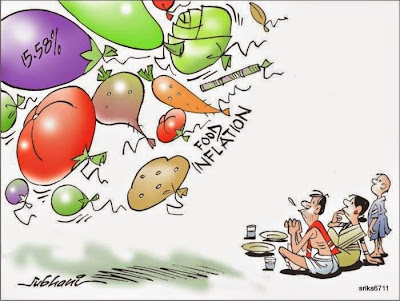Public Policy: Rising Food Inflation will Destabilize Economic Recovery
Growing Challenges of Food Inflation due to
Shortsightedness in Policy Making Process
By:
Vijay
Sardana
Are we really serious about controlling food
inflation?
India can spend Rs. 80,000
Crores for Commonwealth Games for 20 days event but the such enthusiasm and
determination was missing when it came to construction of storage facilities
to protect food from deterioration. What is the return on investment after the
sports event is over, I have no idea. But investment on warehouses and storage
facilities will definitely save about Rs. 80,000 crores of food for India every year. This will also help in
controlling inflation to some extent? Why these facilities cannot be created the
way we invested and created facilities for common wealth games.
Why this is not happening with same vigour? Who will answer this? Can someone ask this question in Parliament to know the answer from the government. Are we really serious in controlling food inflation? I doubt.
Why this is not happening with same vigour? Who will answer this? Can someone ask this question in Parliament to know the answer from the government. Are we really serious in controlling food inflation? I doubt.
Globally food pricing are going
up for various local and global reasons. World market prices for all major food
commodities have risen sharply to historic highs in last three years. Many
factors have contributed to the run-up in food commodity prices.
Some factors reflect trends of
slower growth in production and more rapid growth in demand that have contributed
to a tightening of world balances of grains and oilseeds over the last decade.
Recent factors that have further tightened world markets include increased
global demand for biofuels feedstocks and adverse weather conditions in some
major grain and oilseed producing areas in many parts of the world.
Economic factors that have added
to global food commodity price inflation include the declining value of the
U.S. dollar, rising energy prices, increasing agricultural costs of production,
growing foreign exchange holdings by major food-importing countries, and
policies adopted recently by some exporting and importing countries to mitigate
their own economic needs through tax collection. All these have contributed for
food price inflation.
Are agriculture production
policies and plans relevant to meet future challenges?
Due to various other priorities and lack of
foresight by policy makers, neglect of agricultural research and development by
governmental and international institutions may have contributed to the slowing
growth in crop yields. Stable food prices during the last two decades have led
to some complacency about global food concerns and reduction in R&D funding
levels. Although private sector funding of research has grown because, private
sector research has generally focused on innovations that private companies
could sell to producers at premium due to lack of support and new varieties
from public research institutions. Interestingly, the focus of private research
was mainly to develop cost-reducing options rather than yield enhancing
technological developments. Publicly funded research more likely to focus on
innovations that would increase yields and production, particularly in parts of
the world where farmers are unable to pay royalties for new varieties of seeds.
Unfortunately the outcome of public sector is not able to meet the growing
demand of food for the growing population.
Existing
policies and approaches will not work for future:
Other trends show an even longer
history of gradually slowing production growth.
- For decades, each year a small percentage of the world’s agricultural land has been converted to non-agricultural uses.
- The ability to obtain more water for agricultural uses have gradually become more difficult, either because gravity-flow irrigation systems are more difficult and expensive to develop, or because irrigation wells have to be dug deeper as water tables decline.
- Climate change has increasingly become a concern, although its impact on crop production is still unclear, but earlier indicators are showing negative implication of crop production due to change in weather profile and changing biotic stress on the crops from existing seeds.
Changing Food
Habits may impact balance of food supplies:
Global consumption of meat has been growing
much more rapidly than consumption of grains and oilseeds. Between 1985 and
1990, production of meat (beef, pork, chicken, and turkey) rose more than 3
percent per year. Since this was well above the world’s population growth rate
of 1.7 percent per year, per capita consumption was able to climb by 1.4
percent per year.
Although the average growth rates
in production and per capita consumption of meat have declined somewhat since
1990, they are still well above the growth rates for aggregate use of grains
and oilseeds.
Animals will compete for Human
foods:
As the demand for meat rises, the
demand for grain and protein feeds used to produce the meat grows
proportionally more quickly. Feed-to-meat conversion rates vary widely
depending on the class of animal and the production practices used to produce
the meat.
Domestic compulsions will
distort prices in world market
The rapidly increasing world prices for food
grains, feed grains, oilseeds, and vegetable oils caused domestic food prices
at the consumer level to rise in many countries. In response to rising food
prices, some countries began to take protective policy measures designed to
reduce the impact of rising world food commodity prices on their own consumers.
Introduction of export taxes will increase the international prices of the
commodities. Such measures typically force greater adjustments and higher
prices onto global markets.
Socio-political challenge will become more complicated for India
Rising food commodity prices tend to
negatively affect lower income consumers more than higher income consumers.
Lower income consumers spend a larger share of their income on food. Staple
food commodities such as wheat, rice, pulses and oilseeds account for a larger
share of food expenditures in low-income families. Consumers in low-income,
food-deficit societies are more vulnerable because they must rely on local supplies.
These supplies will also become expensive because alternate options are either
not available or usually will purchase at higher prices. Societies receiving
food aid through public distribution system based on fixed budgets will receive
smaller quantities of food.
Food Subsidy burden will
increase
A number of factors will decide how
much of an increase in food commodity prices will pass through to consumers’
budgets. These can be the percentage of income spent on food, the percentage of
retail food expenditures spent on staple foods, government policy for external trade
and domestic food policies. This is a complex situation for countries with high
population densities.
Future domestic food prices
will reflect international policies
In assessing prospects for the future, there
are a number of uncertainties and concerns:
Global economic growth: If rapid growth continues, particularly in
developing countries, it will continue to put upward pressure on food commodity
prices through increases in food demand.
Energy prices: If petroleum prices continue to rise, costs
of agricultural production will rise, as will the cost of processing, and the
cost of transporting products to markets both within a country and exporting to
other countries. Continued high petroleum prices will also sustain the global
incentives to produce more biofuels.
Biofuels production: Global
growth in biofuels production begins to slow in the next several years and
production from grains and oilseeds flattens out in the next half decade. World
food commodity prices are not projected to retreat to past levels. However,
several years into the future, the underlying long-term trend in rapidly
increasing global demand is expected once again to be the primary contributor
to future upward pressure on food commodity prices.
With such low world stocks of
food commodities, food prices are vulnerable to a production shortfall in one
or more major production areas. If a significant shortfall occurs this year due
to weather or disease, food prices might continue to rise sharply from the
current high level. Although trade flows can mitigate some of these effects,
new or existing trade restrictions or barriers can have impact on domestic price.
Example: case of coal imports from Indonesia.
However, if good crop production
conditions exist in the country and world in the next six months, food
commodity prices could come down significantly from their current highs. But
there is big if.
What is the Policy action plan to
address the following issues?
- Availability of Cost of inputs: Continued increases in production costs, especially in energy-related costs, will restrain the world’s production response. Higher costs for fertilizer, fuel, and seeds could cause farmers without access to credit to plant less than they otherwise would have, or to shift to crops requiring fewer inputs.
- Deteriorating cropland with respect to quantity and quality: What will be the long run impact of higher world food commodity prices on the amount of land used to produce the crops? What is the productivity of the land that will be used to increase production?
- Water shortages: How quickly will constraints on the amount of water available for agricultural production become more widespread? What is the water conservation policy for the country? What are the incentives or encouragement to conserve water?
- New technologies for agriculture inputs like seed varieties and use of biotechnology should be explored: Will higher food prices encourage some countries to adopt the use of biotechnology for crops? Will future research focus more on yield-enhancing varieties rather than cost-reducing innovations? How to address biodiversity issues when food prices are going up?
- Tangible response to climate change based on scenario analysis: How will climate change affect agricultural production? How will it change temperatures, rains, the length of growing seasons, and variability of yields? How, and under what circumstances, will climate change increase and/or reduce production? In affected regions, how difficult will it be for producers to shift to different crops, to adopt new cropping patterns, and to adjust production practices to the new environment?
- Food Sourcing from world market will compromise Independent policy making ability of India: Food is very powerful foreign policy tool. Rising pulses and edible oil prices are live examples. It will also drain out scares foreign exchange reserves. Trade off between fuel and food import is not going to be easy under any situation. These will serious impact out policy planning ability and foreign policy. Look around the world, countries depended on imported food for survival, are attached to a powerful political block with exportable surplus of food. At the same time they do not have independent voice of their own.
As largest democracy, can India
afford to lose its independent voice in world due to food inflation? Earlier
signals are indicating we are losing our independent voice in global forums.
Food inflation
encroaches on Right to Life:
Right to
life is fundamental right under constitution, keep citizens hungry is violation
of fundament rights of citizens. Who is accountable? How long country has to
wait to get the solution to the problem of food inflation? It is important to
note hungry will wait for policy they will take law in hand to feed their
children. Are we waiting for that day?
What do you say?
Do send your comments / feedback with your
suggestions….



Comments
Post a Comment